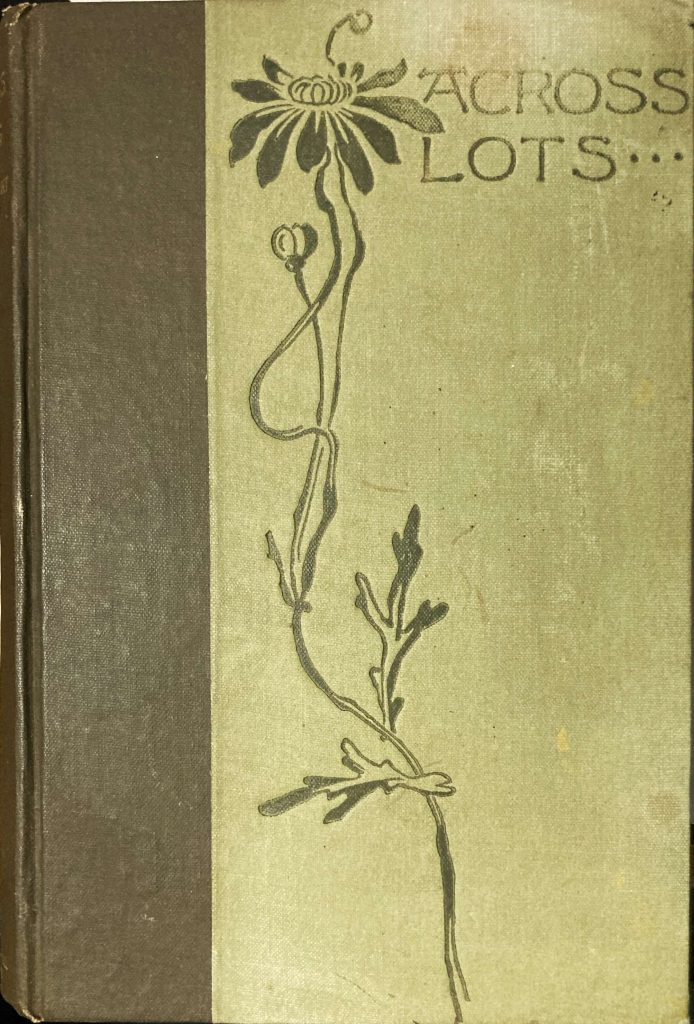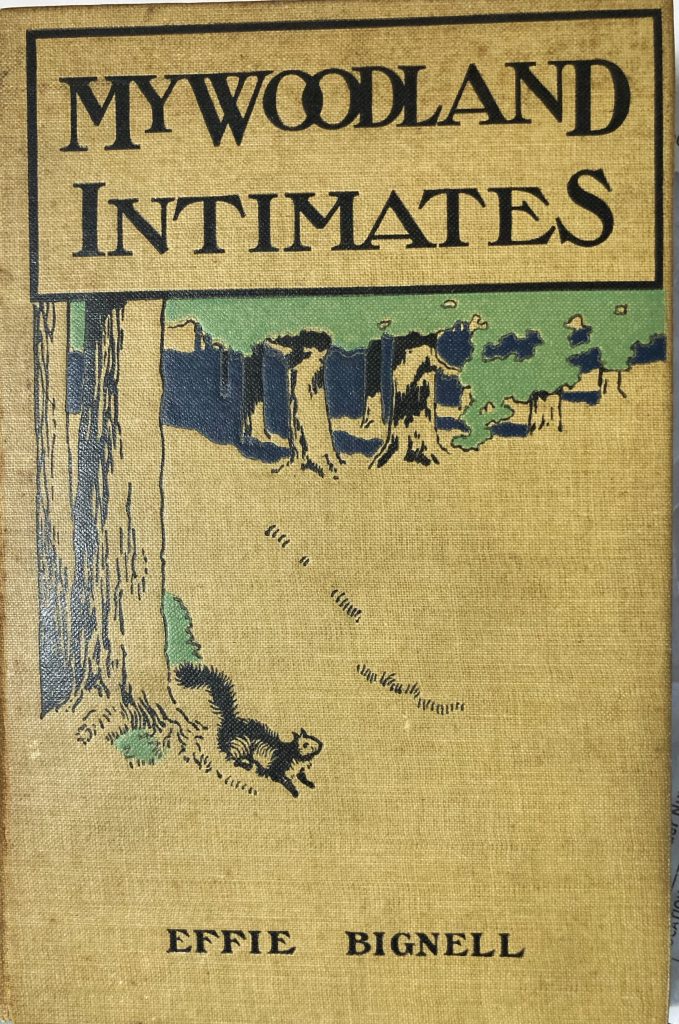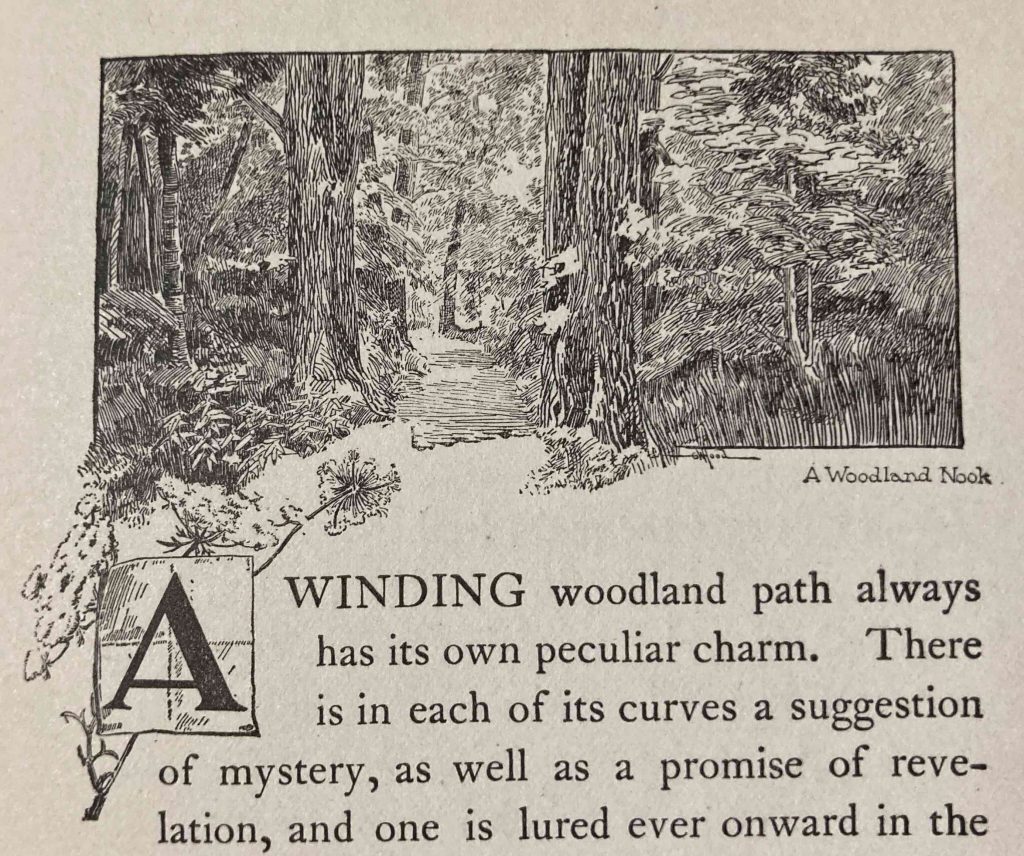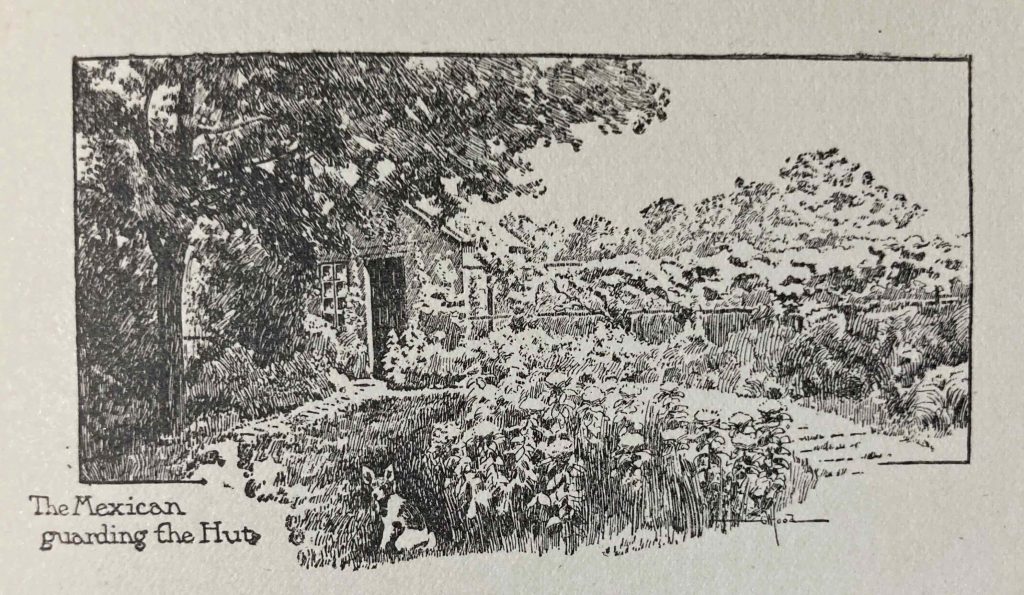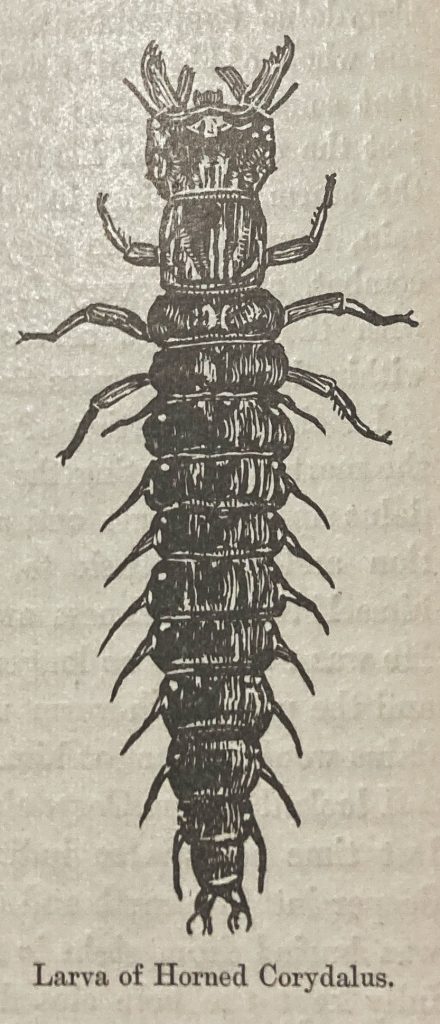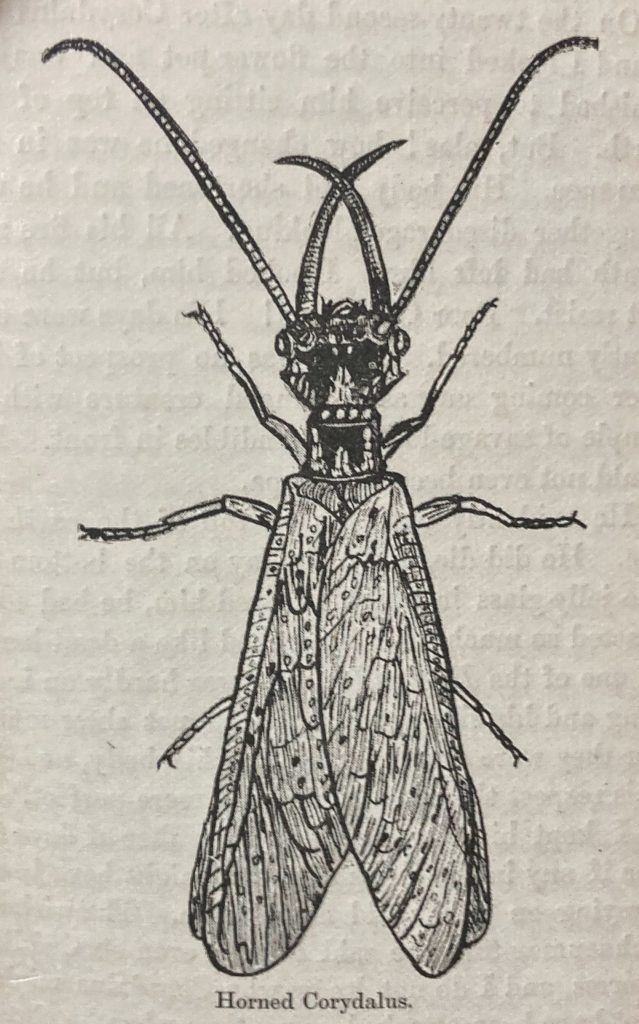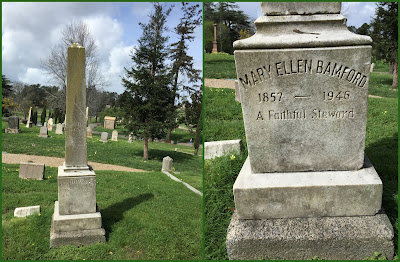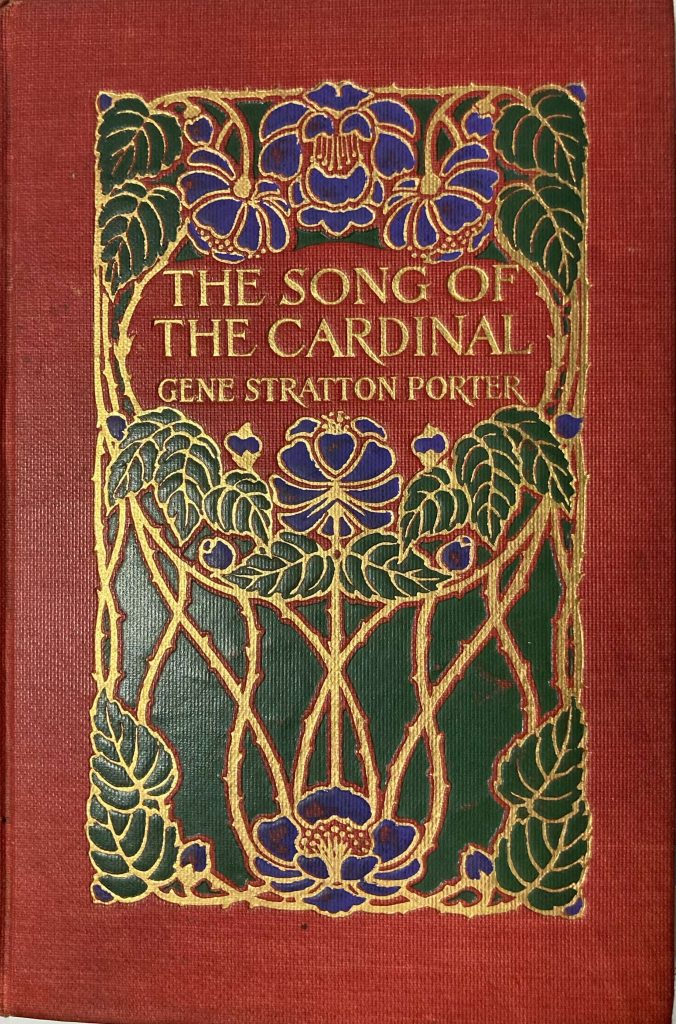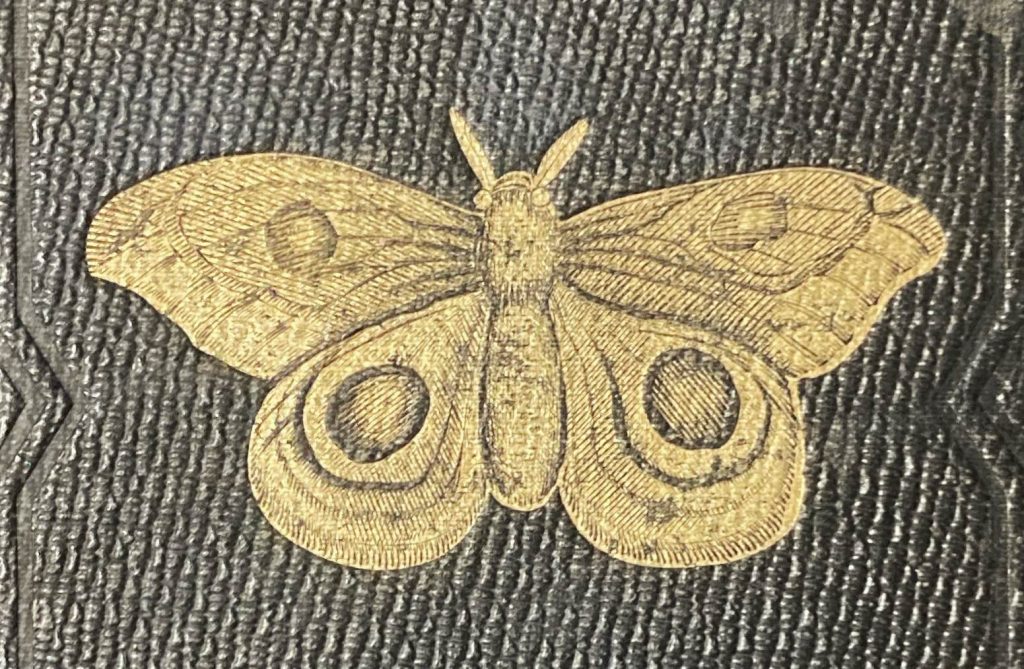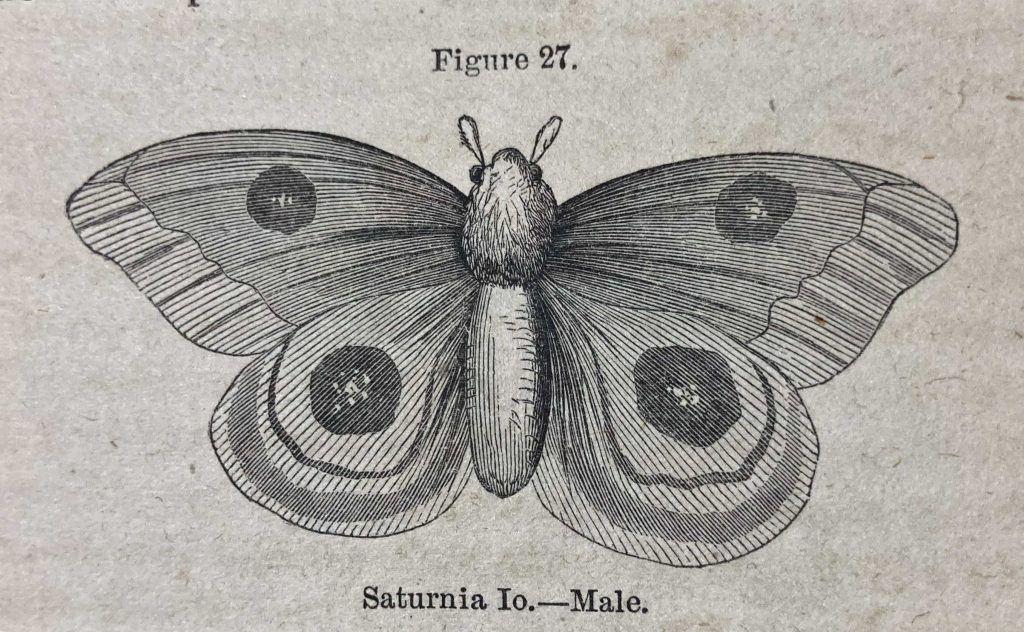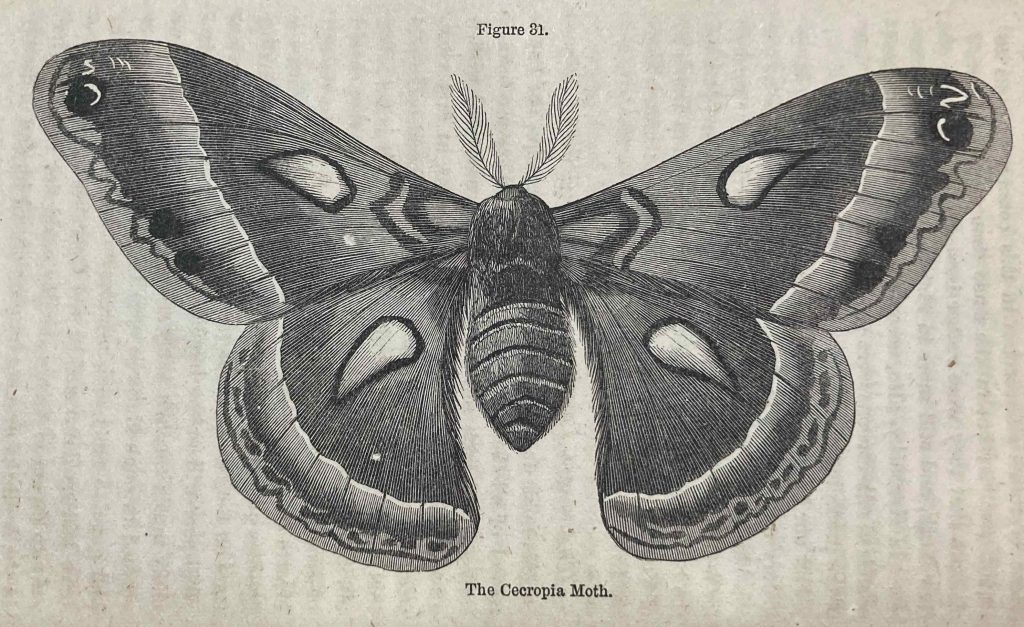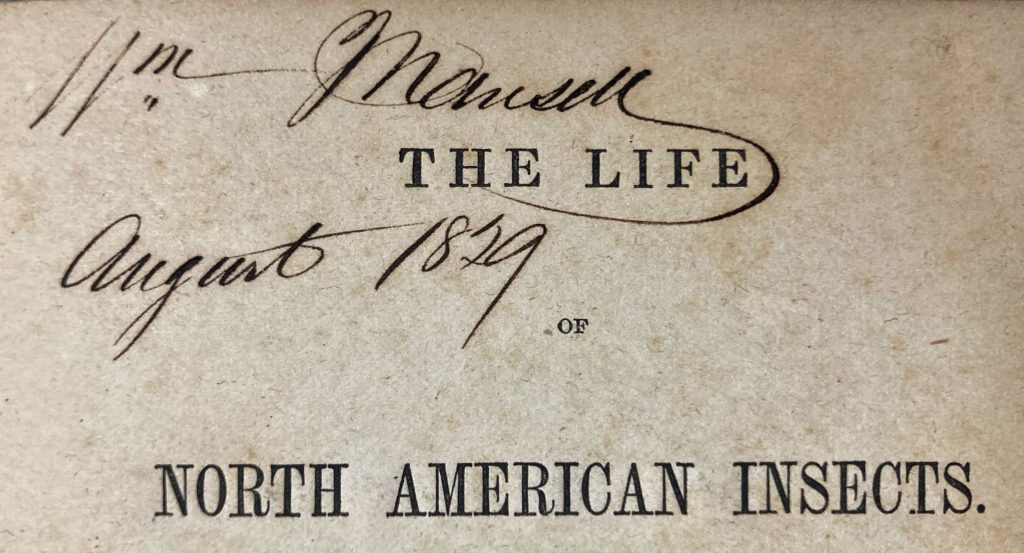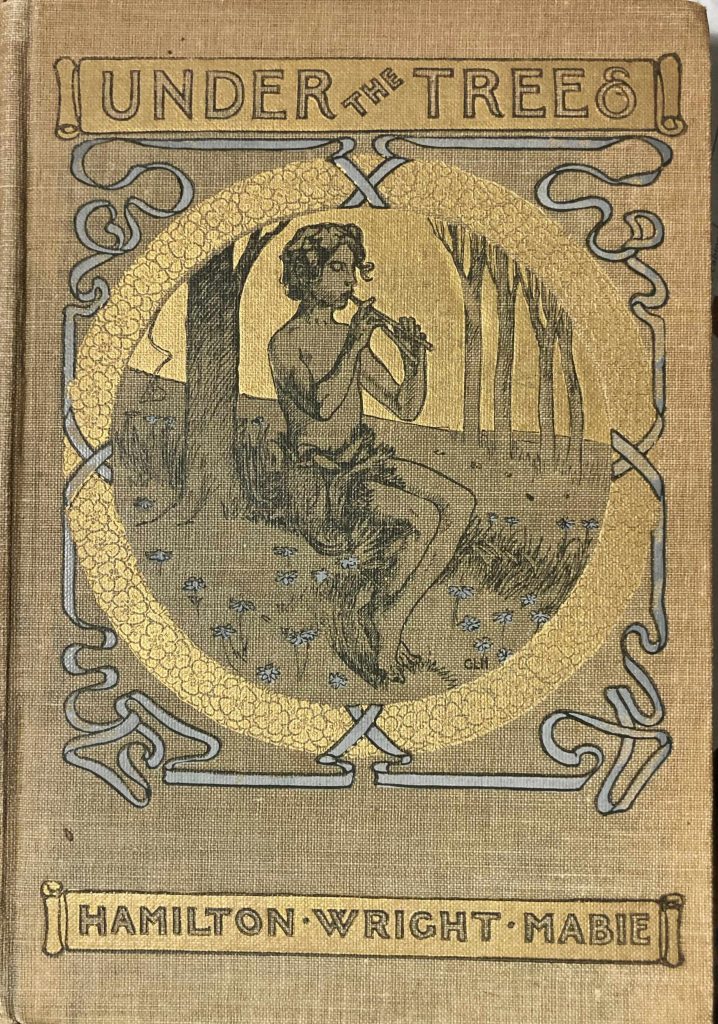
Hamilton Wright Mabie (1846-1916) published over two dozen volumes in his lifetime, many of which were compilations of legends, myths, and fairytales for children. He also wrote fiction and essays on nature and culture. Mabie stands apart from other writers I have read throughout this project in that he was clearly not a scientific naturalist; his inspiration came not from Thoreau, Burroughs, or even Muir, but rather, from Emerson. A transcendental tone infuses his fascinating volume, Under the Trees. Midway through, Mabie reminisces about his first encounter with Emerson’s writing:
As I write, the memory of a summer afternoon long ago comes back to me. The old orchard sleeps in the dreamy air, the birds are silent, a tranquil spirit broods over the whole earth. Under the wide-spreading braches a by is intently reading. He has fallen upon a bit of transcendental writing in a magazine, and for the first time has lerned that t some men the great silent world about him, that seems so real and changeless, is immaterial and unsubstantial — a vision projected by the soul upon illimitable space. On the instant that all things are written with unreality, the solid earth shrinks beneath him. He cannot understand, but he feels what Emerson meant when he said, “The Supreme Being does not build up nature around us, but puts it forth through us, as the life of the tree puts forth new branches and leaves.” That which was fixed, stable, cast in permanent forms was suddenly annihilated by a revelation which spoke to the heart rather than the intellect, and laid bare at a glance the unseen spiritual foundations upon which all things rest at last. From that moment the boy saw with other eyes, and lived henceforth in things not made with hands.
The result of that experience is a book that is difficult to capture in words. On the one hand, it contains the dreamy utterings of an upper-class American male in the Gilded Age, extolling the virtues of an all-benevolent Nature deity that seems to collaborate with and smile upon Western civilization: “Face to face through all his history man has stood with Nature, and to each generation she has opened some new page of her inexhaustible story.” Missing from this worldview is any condemnation of the costs of progress, already becoming apparent in the midst of the Industrial Revolution. There is a passing reference or two to cities, which cannot compare to the bucolic countryside. But the sufferings of the urban poor and the subjugation of Native Americans have no space here. Nor does the book — unlike a handful of other works at the time — mention the wanton killing of birds and buffalo underway back then. This is a pastoral idyll in the manner of Virgil’s Georgics. Every glass is full (with wine, no doubt), and the writer spends many hours enraptured with visions of paradise. There is a naivete here that is at once both compelling and somewhat reprehensible.
And yet. And yet, there are some truly beautiful passages here where Mabie’s transcendental vision carries the reader away from the mundane world of the moment — a world filled with nouns that all seem so real and substantial — into a world of verbs, infused by forces of constant change. In flowing prose, Mabie makes the hydrologic cycle come alive as a Buddhist vision of cosmic transformation:
The rivers are the great channels through which the ceaseless interchange of the elements goes on; they unite the heart of the continents and the solitary places of the mountains with the universal sea which washes all shores and beats in melancholy refrain at each pole. Into their currents the hills and uplands pour their streams; to them the little rivulets come laughing and singing down from their sources in the forest depths. A drop falling from a passing shower into the lake of Delolo may be carried eastward, through the Zambezi, to the Indian Ocean, or westward, along the transcontinental course of the Congo, to the Atlantic. The mists that rise from great streams, separated by vast stretches of territory, commingle in the upper air, and are carried by vagrant winds to the wheat-fields of the far Northwest or the rice-fields of the South. The ocean ceaselessly makes the circuit of the globe, and summons its ributaris along all shores to itself. But it gives even more lavishly than it receives; day and night there rise over its vast expanse those invisible clouds of moisture which diffuse themselves through the atmosphere, and descend at last upon the earth to pour, sooner or later, into the rivers, and be returned from whence they came.
Endless flow. That is the underlying vision here. Everything we encounter is temporary- a book, a mountain, or a blooming rose. Nature is always at play, and by recognizing these transformations and how they point to one unified reality, we can transcend daily life’s mundane worries and demands and find lasting peace. Buddhism for the Gilded Age.
If I permit my thought to rest upon this fragrant flower, to touch petal and stem and root, and unite them with the vast world in which, by a universal contribution of force, they have come to maturity, I find myself face to face with the oldest and deepest questions men have ever sought to answer. Elements of earth and sea and sky are blended here in one of those forms of radiant and vanishing beauty with which the unseen life of Nature counts the years in endless and inexhaustable profusion. As it budded and opened into full flower in the garden, how complete it seemed in itself, and how isolated from all other visible things! But in reality how dependent it was, how entirely the creation of forces as far apart as earth and sky! The great tide from the Unseen cast it for a moment into my possession; for an hour it has filled a human home with its far-brought sweetness; to-morrow it will fall apart and return whence it came. As I look into its heart of passionate colour, the whole visible universe, that seems so fixed and stable, becomes immaterial, evanescent, vanishing; it is no longer a permanent order of seas and continents and rounded skies; it is a vision painted by an unseen hand against a background of mystery… It is the momentary creation of forces that stream through it in endless ebb and flow, that are to-day touching the sky with elusive splendour, and to-morrow springing in changeful loveliness from the depths of earth. The continents are transformed into the seas that encircle them; the seas rise into the skies that overarch them; the skies mingle with the arth, and send back from theuplifted faces of flowers greetings to the stars they have deserted…
In the unbroken vision of the centuries all things are plastic and in motion; a divine energy surges through all; substantial for a moment here as a rock, fragile and vanishing there as a flower; but everywhere the same, and always sweeping onward through its illimitable channel to its appointed end. It is this vital tide on which the universe gleams and floats like a mirage of immutability; ever the same for a single moment to the soul that contemplates it: a new creation every hour and to every eye that rests upon it.
The world is spinning, and I am dizzy with his prose. I pause, look down to earth (more precisely, the dust-infused carpet of my cluttered home office), and catch my breath. I think I may have reached my daily limit for cosmic rapture, and it is only 8 am.
Without a doubt, my favorite essay in this collection is “The Earliest Insights” in which Mabie turns his thoughts toward the mysteries of the childhood experience with nature. Here, in his flowery way, he reaches many of the same realizations I have held for years. Specifically, as Edith Cobb noted in her Ecology of Imagination in Childhood, for young children, the border between self and other has not yet developed, enabling the child to have a consciousness infused with nature — continuous with it, fully present with it. Amazingly, Mabie’s thoughts on the quest to rediscover that childhood way of being in nature (which I have pondered all my life) seem to presage T.S. Eliot’s vision in “Little Gidding” (published 51 years later) of returning to where we started our explorations and knowing the place for the first time. Could Eliot have encountered Mabie’s work? Unlikely though that may seem, Mabie also writes of children under an apple tree, just as children in an apple tree appear in the very next lines of “Little Gidding.” And did I mention that a rose bush appears in the essay, too? First, here is the extended passage from T.S. Eliot, published in 1942:
We shall not cease from exploration
And the end of all our exploring
Will be to arrive where we started
And know the place for the first time.
Through the unknown, unremembered gate
When the last of earth left to discover
Is that which was the beginning;
At the source of the longest river
The voice of the hidden waterfall
And the children in the apple-tree
Not known, because not looked for
But heard, half-heard, in the stillness
Between two waves of the sea.
And here is Mabie’s more labored yet still inspiring prose, originally published in 1891:
When I came across the field a few moments ago, a voice called me from under the apple trees, and a little figure, with a flush of joy on her face and the fadeless light of love in her eyes, came running with uneven pace to meet me. How slight and frail was that vision of childhood to the thought which saw the awful forces of nature at work, or rather at play, about her! And yet how serene was her look upon the great world dropping its fruit at her feet; how familiar and at ease her attitude in the presence of these sublime mysteries! She is at one with the hour and the scene; she has not begun to think of herself as apart from the things which surround her; that strange and sudden sense of unreality which makes me at times alien and a stranger in the presence of nature, “moving about in the world not realised,” is still far off. For her the sun shines and the winds blow, the flowers bloom and the stars glisten, the trees hold out their protecting arms and the grass waves its soft garment, and she accepts them without a thought of what is behind them or shall follow them; the painful process of thought, which is first to separate her from Nature and then to reunite her to it in a higher and more spiritual fellowship, has hardly begun. She still walks in the soft light of faith, and drinks in the immortal beauty, as the flower at her side drinks in the dew and the light. It is she, after all, who is right as she plays, joyously and at home, on the ground which the earthquake may rock, and under the sky which storms will darken and rend. The far-brought instince of childhood accepts without a question that great truth of unity and fellowship to which knowledge comes only after long and agonising quest. Between the innocent sleep of childhood in the arms of Nature and the calm repose of the old man in the same enfolding strength there stretches the long, sleepless day of question, search, and suffering; at the end the wisest returns to the goal from which he set out.
Mabie closes his essay with a call for regaining the sense of being in Nature that we knew in our earliest years, a way that perceived the flow of natural forces and participated in it: “If we could but revive the consciousness of childhood, if we could but look out once more through its unclouded eyes, what divinity would sow the universe with light and make it radiant with fadeless visions of beauty and truth!” This same quest to see nature anew “through the eyes of a child” has infused much of my thought and work, including doctoral research on sense of place in middle childhood.
But back to Mabie. Or Mabie not. I will leave the author there, with some of his most intriguing writing on nature and children. Plenty of other sections are tedious and overwrought; I will spare the reader those. But the words are not all that comprise the book I read. I consciously sought out the 1902 edition, rather than the first edition from a decade earlier, so that I could experience a truly classic volume (in more ways than one) ornamented in the art nouveau style of turn-of-the-century America by C.L Hinton. His work graces the cover and greets you on the title page:
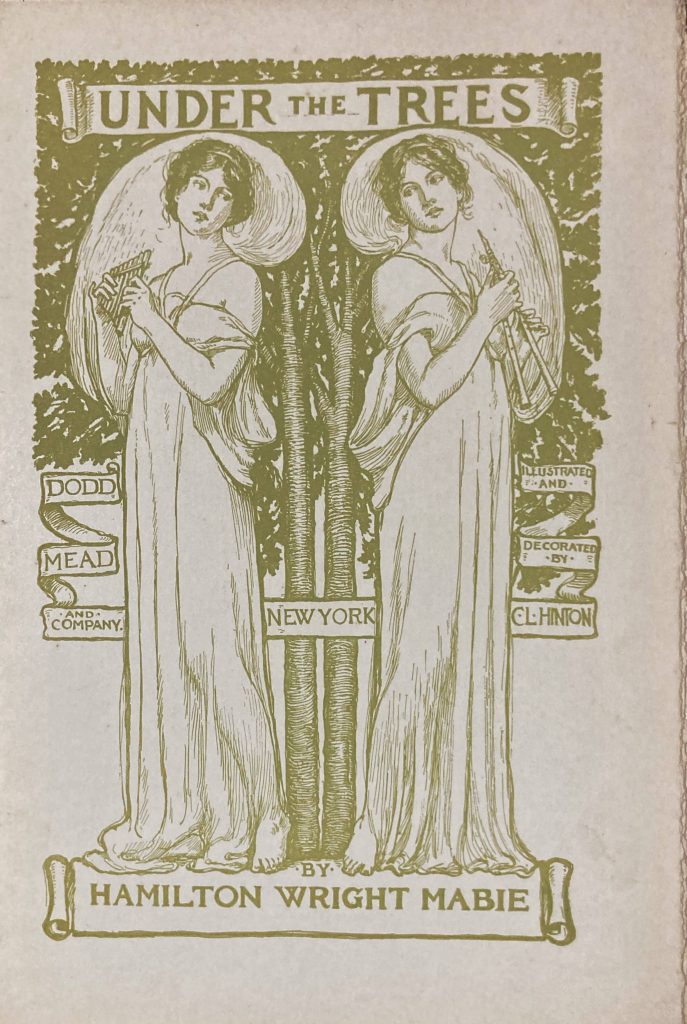
Every page is bordered, on three sides, by scenes of rural nature, filled with youths and satyrs playing musical instruments. The reader is immersed in Hinton’s world.
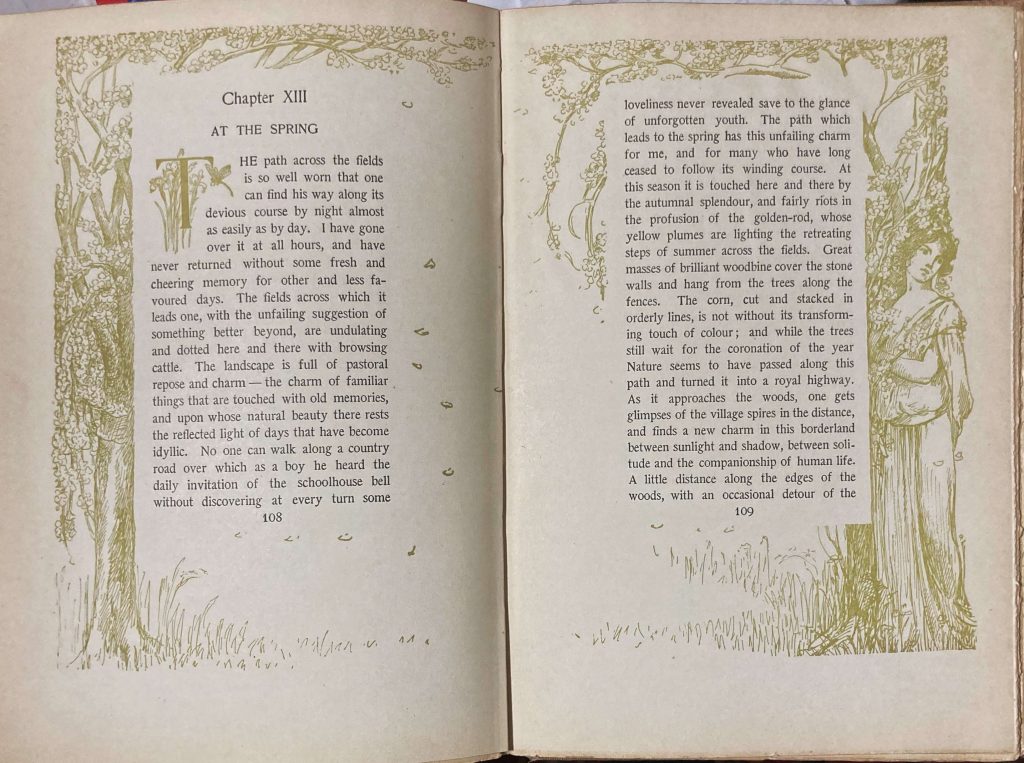
There are also several full-page images in black and white, behind protective translucent pages, depicting barefoot female figures clad in white robes:
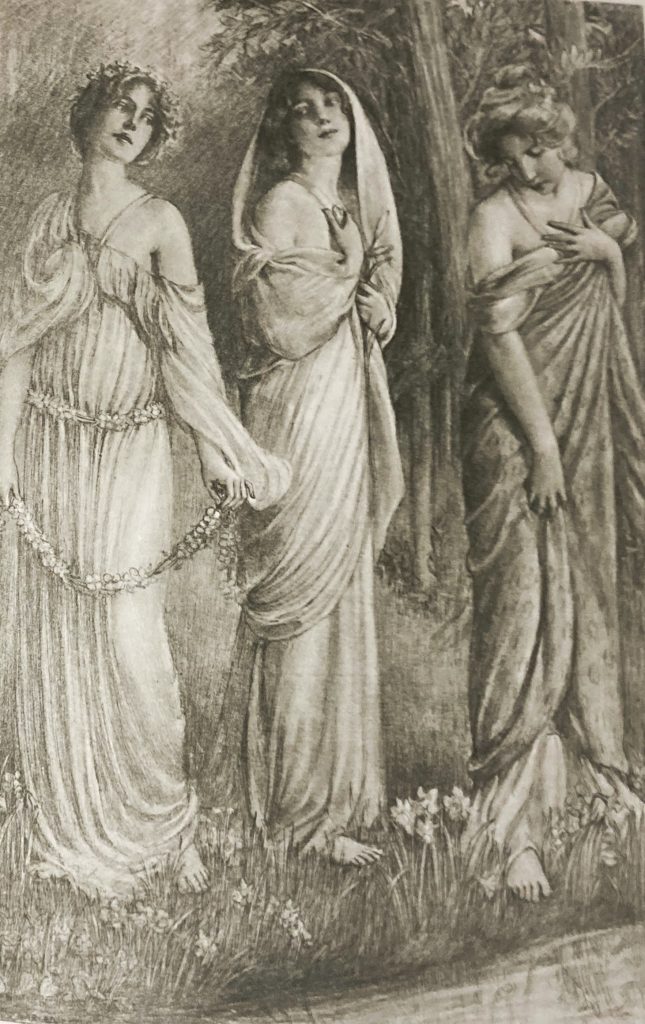
The result is a truly immersive reading experience — a paradisal world that the reader inhabits from the moment he pulls the book off the shelf. The words coalesce with the background images and the full-page artwork and the magnificent gilt cover. The reading experience is the entire work, not just the blocks of text. The book is an Object of Wonder and Mystery, a tribute to the craftsmanship of book design in 1902 America.
